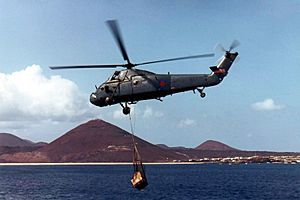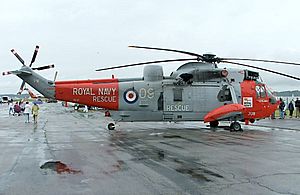History of Royal Navy Helicopter Search and Rescue facts for kids
The Royal Navy has a long history of using helicopters for Search and Rescue (SAR) missions. At first, helicopters were used by the Navy to protect planes flying from warships. Over time, the Royal Navy began sharing the job of providing SAR coverage for the United Kingdom with the Royal Air Force and private companies. The Navy was responsible for two out of twelve SAR areas. However, starting in 2015, both the Royal Air Force and the Royal Navy handed over their civilian SAR duties to private companies working for His Majesty's Coastguard.
Contents
Early Helicopter Rescues
The Royal Navy started using helicopters for search and rescue at sea as soon as they were introduced on warships. In 1953, it was decided that dedicated helicopter SAR teams were needed. These teams would help Fleet Air Arm pilots who had crashed near their home bases.
The first Royal Navy Air Stations to set up their SAR units in 1953 were:
- RNAS Anthorn (HMS Nuthatch)
- RNAS Brawdy (HMS Goldcrest)
- RNAS Culdrose (HMS Seahawk)
- RNAS Eglinton (HMS Gannet)
- RNAS Ford (HMS Peregrine)
- RNAS Gosport (HMS Siskin)
- RNAS Lossiemouth (HMS Fulmar)
The Westland Dragonfly helicopter served in the Royal Navy's SAR role until 1964. It was used alongside the Westland Whirlwind. The Whirlwind was better, with a longer range of 300 nautical miles and a top speed of 95 knots (about 109 mph). The Whirlwind could also handle more complex rescues because it had a larger crew and could carry up to 8 people.
The Great Flood of 1953
In 1953, a huge flood hit East Anglia in the UK and the Netherlands. This happened on the night of January 31. The Royal Navy received an urgent call for help. Twelve Dragonfly HR.1 and HR.3 helicopters from 705 Naval Air Squadron were sent from their base at RNAS Gosport.
In just 7 hours of flying, these helicopters rescued 840 people! One pilot alone saved 111 lives, and another saved 102. For their amazing life-saving efforts, the Commanding Officer, Lt Cdr HR Spedding, received the MBE. Aircrewman IS Craig was awarded the British Empire Medal.
Modernizing Helicopter SAR
In 1964, the Royal Navy replaced the Dragonfly and Whirlwind with the Westland Wessex helicopter. This new helicopter had an even greater range of 478 nautical miles and a top speed of 115 knots (about 132 mph). It could also rescue more people, with space for up to 16.
These Wessex aircraft were used in many rescues. For example, on March 18, 1963, they saved two SAS canoeists who were in trouble off the South Wales coast. The pilot, Lt. R.E. Smith, received an MBE for his bravery. (Even though this rescue was done by a Commando Role crew, all Royal Navy aircrew are trained in search and rescue). In 1968, a Wessex HAS.1 from 706 Naval Air Squadron rescued a lighthouse keeper from Longships Lighthouse near Lands End. Lt. D. Blythe, the pilot, also received an MBE for this rescue.
In 1969, the Westland Sea King was introduced to the Fleet Air Arm (FAA). The Wessex continued its SAR duties alongside the Sea King, which was also used for finding submarines. The Sea King was often called for rescues further away because it had a longer range of 598 nautical miles and could stay in the air for over 4 hours.
One new Sea King from RNAS Culdrose was part of a very brave rescue in January 1974. It saved the crew of the Danish ship SS Merc Enterprise, which had capsized south of Plymouth in a terrible storm. With waves as high as 50 feet and winds of 70 mph, the crew managed to save many survivors. The pilots, Lt Cdr DS Mallock and Lt AR Baker, were awarded the Air Force Cross. The aircrew members, POAcmn DJD Fowles, POAcmn DJ Jackson, and APOAcmn AT Williams, each received the Air Force Medal.
The combination of the Wessex and Sea King helicopters greatly increased the number of rescues during this time. The Sea King's ability to rescue more people also led to more awards for bravery for the SAR crews.
A big improvement for Royal Navy SAR came in April 1988 with the introduction of the Sea King Mk.5, designed specifically for SAR. These Sea King HAS.5s had their submarine-hunting equipment removed. This allowed them to carry more fuel for long-distance rescue missions. With an almost empty cabin, the HAR.5s had lots of space for special rescue gear, medical equipment, and more passengers. This aircraft was the main helicopter for the Royal Navy SAR fleet until 2015, when the service became private.
Until 2015, the Royal Navy SAR service was provided by two squadrons: 771 Naval Air Squadron and Gannet SAR Flight. They were based at RNAS Culdrose (HMS Seahawk) and Prestwick (HMS Gannet), respectively.
SAR Units
- 705 Naval Air Squadron (1953-1974)
- 771 Naval Air Squadron (1961-2015)
- HMS Gannet SAR Flight (2001-2015)
- 772 Naval Air Squadron (1974-1995)
- 819 Naval Air Squadron (1971-2001)
The Future of SAR
In March 2013, the Department for Transport announced a new plan. They signed a contract with Bristow Helicopters Ltd to provide search and rescue helicopter services across the UK. These new operations started gradually from 2015. The new service is expected to be fully ready across the United Kingdom by summer 2017. It will use AgustaWestland AW189 and Sikorsky S-92 helicopters based at ten locations around the UK.
See also
- RAF Search and Rescue Force
- Royal Navy SAR 60





